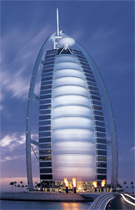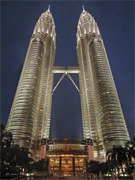Supplying the world's greatest
Cities are changing. More and more tall, large and spectacular buildings are transforming the urban topo-graphy around the world. But these buildings would be nothing without heating and cooling installations that meet the demands of the innovative architecture.
DATE 2023-11-28 AUTHOR Timothy Tore HebbThere is a global competition going on. As the new millennium heralds even greater levels of globalization, cities everywhere are striving to attract their share of businesses and creative people, resulting in the construction of ever taller and more technically advanced buildings. At the same time, important historic buildings are being preserved as a fundamental requirement for achieving a dynamic and vibrant global metropolis.
Usually you only see the exterior of buildings, not the interior that holds the structures together or the heating and cooling solutions that make the buildings accommodating. Alfa Laval has supplied products and solutions for creating a comfortable indoor climate to many prestigious buildings all over the world.
The Louvre and the Paris Opera are two such examples. Instead of using individual systems for each building, French company Climespace supplies some of the greatest historic landmarks and a lot of other buildings in Paris with air conditioning from a central source through a 52-kilometre underground system. Alfa Laval supplies most of the heat exchangers used in Climespace’s district cooling system.
“Many of our clients are located in buildings of particular historic and architectural value and are therefore prohibited from installing individual air-conditioning units on the building themselves,” explains Bertrand Martin, general manager of Climespace.
The Climespace system also brings about important energy and environmental savings. “We have estimated that a building using our system creates 20 percent less carbon dioxide emissions and has 30 percent less refrigerant leakage that one using an individual air-conditioning system,” says Martin.
Tatiana Astanina of Project Management, Comfort and Refrigeration at Alfa Laval, points out the importance of efficient and customized heat exchangers in demanding cooling and heating applications. “These famous and prestigious buildings have a high ‘visibility factor,’ which means the demands on performance and reliability are particularly stringent,” she says.
Louvre, Paris, France
Paris’s famous Louvre was built as a fortress in the 12th century but transformed  during the reign of the Sun King, Louis XIV, and others into the building we know today. It became an art museum in 1793. Arguably the most-visited museum in the world, the Louvre opens its doors to some 6 million visitors each year, most of whom are there to see its priceless contents. About 35,000 different works are on display in the 65,000-square-metre exhibition space, but almost 10 times that number are in storage.
during the reign of the Sun King, Louis XIV, and others into the building we know today. It became an art museum in 1793. Arguably the most-visited museum in the world, the Louvre opens its doors to some 6 million visitors each year, most of whom are there to see its priceless contents. About 35,000 different works are on display in the 65,000-square-metre exhibition space, but almost 10 times that number are in storage.
The Louvre’s permanent collection contains pieces created up to 1848, but the museum also houses temporary contemporary exhibitions. What also gives the museum a contemporary feeling is the glass pyramid in the central courtyard, which these days serves as the main entrance.
Alfa Laval’s input
The Louvre’s district heating and cooling systems are supported on location by gasketed plate heat exchangers and steam substations from Alfa Laval. The space requires consistent temperature and humidity – a real challenge considering the fluctuating crowds in in the museum at any given time.
Burj Al Arab, Dubai, United Arab Emirates
 The 321-metre-tall, five-star Burj Al Arab looks like a sail under full wind – the effect intended by the architect, Tom Wright, of the renowned UK engineering consultancy firm Atkins. Wright designed the hotel to resemble a typical Arabian sailing vessel, called a dhow. The hotel stands on its own small island, and guests can chose from 202 suites on 28 floors. The building, which dominates the Dubai coastline, contains more than 70,000 cubic metres of concrete and 9,000 tonnes of steel.
The 321-metre-tall, five-star Burj Al Arab looks like a sail under full wind – the effect intended by the architect, Tom Wright, of the renowned UK engineering consultancy firm Atkins. Wright designed the hotel to resemble a typical Arabian sailing vessel, called a dhow. The hotel stands on its own small island, and guests can chose from 202 suites on 28 floors. The building, which dominates the Dubai coastline, contains more than 70,000 cubic metres of concrete and 9,000 tonnes of steel.
The hotel’s management has made a great effort to ensure that it is one of the highest-ranked luxury hotels in the world. It has a check-in desk on every floor, as well as other touches that add up to top service. The Institutional Investor Magazine and the World Travel Awards (2007) have acknowledged Burj Al Arab as the best hotel in the world.
Alfa Laval’s input
With outside temperatures reaching 50 degrees Celsius, the 180-metre-tall atrium in the lobby poses special cooling challenges. The possibility of an indoor condensation cloud is very real. Alfa Laval supplies engineering skills and climate systems that help alleviate the risk.
Petronas Twin Towers, Kuala Lumpur, Malaysia
 At a staggering 451 metres, Kuala Lumpur’s Petronas Twin Towers are the world’s tallest construction of their kind. Halfway up, visitors unconcerned by heights can walk between the towers on the highest double-decker bridge in the world. The towers also contain office space – 395,000 square metres of it. Seventy-eight elevators are needed to transport people up and down the 88 floors. Argentine-American architect César Pelli is behind the buildings, which appear to have been constructed for a sci-fi movie.
At a staggering 451 metres, Kuala Lumpur’s Petronas Twin Towers are the world’s tallest construction of their kind. Halfway up, visitors unconcerned by heights can walk between the towers on the highest double-decker bridge in the world. The towers also contain office space – 395,000 square metres of it. Seventy-eight elevators are needed to transport people up and down the 88 floors. Argentine-American architect César Pelli is behind the buildings, which appear to have been constructed for a sci-fi movie.
When completed in 1998, the towers were the tallest buildings in the world, with foundations 120 metres deep – still the deepest foundations for a building anywhere. Concrete, used on all levels of the structure, is the key construction material. The steel-and-glass facade has been decorated with motifs found in Islamic art, reflecting Malaysia’s Muslim faith.
Alfa Laval’s input
Four very large, gasketed plate heat exchangers from Alfa Laval act as district cooling substations, while six others are circuit breakers on intermediate levels.
Sazka Arena Prague, Czech Republic
 A venue for hockey, ballet and international musical acts, the Sazka Arena seats 17,000 spectators around the hockey rink and thousands more during cultural performances. Home to Czech Extraliga hockey team HC Slavia Praha, it is one of only a few arenas outside North America that is built to NHL/NBA regulations.
A venue for hockey, ballet and international musical acts, the Sazka Arena seats 17,000 spectators around the hockey rink and thousands more during cultural performances. Home to Czech Extraliga hockey team HC Slavia Praha, it is one of only a few arenas outside North America that is built to NHL/NBA regulations.
The original building has a floor space of 35,000 square metres on six floors, with plans in the future for an international hotel, shopping and office areas, a congress centre and an extensive public park. The arena attracts almost 1.5 million visitors a year.
Alfa Laval’s input
Fifteen gasketed, brazed plate heat exchangers from Alfa Laval help turn the arena into an ice rink and at the same time retain a comfortable indoor climate.
More prestigious projects involving Alfa Laval
- Bankasi Towers, Istanbul, Turkey: Three tall buildings house the largest office complex in Europe, with 224,357 square metres of floor space.
- Turning Torso, Malmo, Sweden: The slightly twisted, 190-metre-tall building has changed Malmo’s skyline forever.
- Two International Finance Centre, Hong Kong, China: With a height of 420 metres, Tower 2 of the International Finance Centre, or 2IFC, sets itself apart in a city full of towers.
- The Burj Dubai Tower, Dubai, United Arab Emirates: When completed it will be the world’s tallest building and house exclusive offices, residential suites and more.
- FieraMilano, Milan, Italy: This is one of Europe’s most high-tech trade fair venues with 400,000 square metres of indoor exhibition space and an additional 60,000 square metres outdoors.
- Venetian Resort Hotel Casino, Las Vegas, in the US state of Nevada: With 7,074 rooms and suites it is the largest hotel complex in the world.
- Federation Tower West, Moscow, Russia: This innovative steel-and-glass building stands 243 metres high.
- The Pushkin Museum of Fine Arts, Moscow, Russia: Completed in 1912, today the museum houses collections of foreign art dating back to ancient times.
